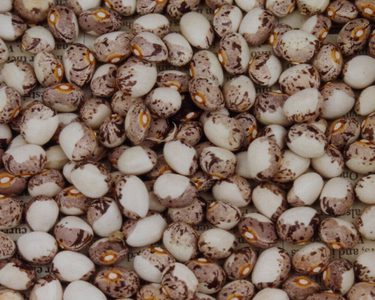What makes our climbing beans so colourful?

Our growing collection of heritage bean seeds are donated from all corners of the world - and tell colourful stories of love, friendship, family and war.
“Open pollination means that every plant is slightly genetically different from another. These differences can express themselves in many ways but often through a difference in colour or pattern,” says Catrina Fenton, head of the Heritage Seed Library.
“The colour of the pod or seed can also be affected by the stage of maturity when they are picked. For example, our Mrs Fortune’s beans produce smooth, green and blue mottled pods, which become a darker blue when mature. While the whole pods can be eaten, the seeds inside are ready to harvest as a dried bean when the pod has dried out and seed coat has fully matured to white with purple stripes.
“It's also quite common for some varieties to produce a proportion of ‘inverted’ seed coat colours. For example, our Major Cook bean is mostly white pods with purple stripes but some of the seeds will end up being purple with white stripes.”

As well as looking unusual and beautiful, their conservation is important for preserving biodiversity and important growing characteristics.
“The Heritage Seed Library is a living and constantly evolving collection of important seed varieties. Many of these seeds are grown by families for generations, or dropped from commercial catalogues, but are vitally important in preserving vegetables with unique characteristics, many of which are suited to particular growing places and conditions,” adds Catrina. “The greater the diversity in our food crops the better resilience we will have against pests and diseases and the changing climate.”

Five to try from our 2024 Heritage Seed List
- The Hidatsa Shield Figure climbing French bean is named after the Hidatsa Native American tribe of North Dakota, and the seed coat's pattern is said to resemble a warrior bearing a golden shield, though you might need to squint a bit!
- The Brown Soldier bean from France is an old drying bean that derives its name from the markings around the hilum (the part of the seed which attaches it to the pod), which resemble a soldier standing to attention.
- The purple and white Major Cook Bean is thought to have originated from Southampton in around 1900 by experimental horticulturist Alderman Vokes (Major Cook’s Grandfather). Major Cook himself was a keen gardener, growing prize-winning vegetables with his grandfather, and he was trained at Kew before serving in the Middle East during WWII.
- Mrs Fortune’s bean, which have a green and blue colour, were donated by two allotment neighbours in Bristol who were given the bean by Mrs Fortune, who had in turn acquired the beans from the retired Head Gardener at Windsor. Allegedly, the beans were a favourite of the Royal Family!
- Four of the beans in this year’s list derive from the Ukraine. One example is the Palochka bean, which has an attractive black seed, and originated from the village of Kostilnyky in Western Ukraine.
Click here to view this year's Seed List, and if you're not a member go to gardenorganic.org.uk/join
